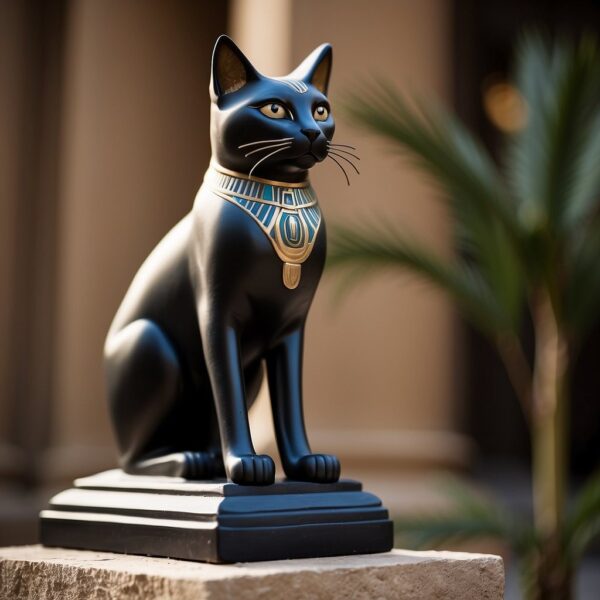
Bastet, the Cat Goddess: Unveiling Ancient Egypt’s Divine Protector
In ancient Egyptian culture, Bastet represents an enigmatic figure that has captivated historians and the public alike. Initially depicted as a fierce lioness, The goddess’s image evolved into a more benign cat goddess, a shift reflecting her complex character in the diverse Egyptian pantheon. Recognized as the daughter of Re, the sun god, her domain extended over protection, cats, fertility, and music, displaying her multifaceted nature and significant role in ancient Egyptian religion and society.
Bastet is often portrayed with a cat’s head and a female body, exemplifying her association with domestic cats, a revered animal in Egypt viewed as protectors from vermin and evil spirits. She was worshipped as a goddess who safeguarded homes and families, particularly in matters concerning women and children. Bastet’s influence permeated through various aspects of Egyptian life, from the mundane to the spiritual, ranging from her protective duties to her presence in the narratives surrounding the afterlife.
Key Takeaways
- Bastet, an Egyptian goddess, transitioned from a lioness war deity to a cat goddess symbolizing protection and domesticity.
- She was the daughter of the sun god Re, embodying fertility, music, and warfare, among other aspects.
- Bastet was worshipped extensively and featured prominently in Egyptian culture, art, and religion.
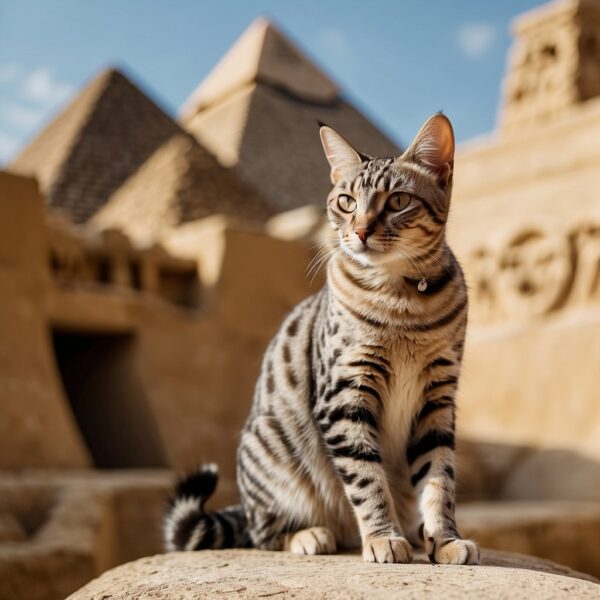
Origins and Historical Evolution
Bastet, venerated from the Second Dynasty of Ancient Egypt, has undergone significant transformations throughout history. Her role and representation evolved, mirroring changes in society and religious beliefs.
Early Worship and Transformation
Early Worship: Initially, Bastet, also known as Bast, was depicted as a fierce lioness, embodying the aggressive aspects of motherhood and protection. During the Second Dynasty, her image served as a symbol of royalty and warfare, earning her a seat of honor in the Egyptian pantheon.
Transformation: Over time, her image softened to that of a domesticated cat, reflecting a broader shift in her worshippers’ views. Post-1500 BCE, her nurturing features were emphasized, and she became increasingly associated with home and family, alongside her protective duties.
Bastet in Egyptian Mythology
Mythological Role: As the daughter of the sun god, Re, Bastet functioned as the ‘Eye of Re,’ becoming an instrument of his vengeance while also safeguarding his authority. In Egyptian mythology, she played a dual role, acting as both a fierce defender and a gentle nurturer.
Bastet’s Cult Center: Bubastis
Cult Center: Bubastis, located in the Nile River delta, was the primary cult center for the worship of Bastet. This city became a hub for her followers and a place of annual festivities celebrated in her honor. At Memphis, another prominent site, her influence intertwined with the local pantheon, further elevating her importance across Egypt.
Iconography and Attributes
Bastet, the Egyptian goddess, is iconic for her manifestations with feline features. Her representation fluctuated between a lioness goddess and a cat-headed goddess, each signifying a distinct aspect of her divinity.
Depictions and Symbols
Bastet initially bore the visage of a lioness, symbolizing her fierce and warlike nature. Over time, she softened into the more familiar cat-headed goddess, highlighting her protective and nurturing qualities. This transformation reflects her dual roles as a guardian of the home and a symbol of fertility and womanhood. Common symbols associated with Bastet include:
- Lioness head: Illustrating her early association with power and aggression.
- Cat-headed figure: Denoting her later connection with domesticity and protection.
- Aegis: Sometimes depicted with a lioness head, reinforcing her role as a protective deity.
- Eye of Ra: Representing her aspect as a fierce protector.
The Sistrum and Its Significance
The sistrum, an ancient percussion instrument, is frequently depicted in the goddess’s hand and is closely tied to her worship. It’s not only a symbol of her presence but also:
- Embodies the sound of music and dance which were integral parts of her cult.
- Was believed to ward off evil spirits, resonating with her role in protecting the home.
Roles and Associations
Bastet, a revered Egyptian goddess, assumed various pivotal roles and held significant associations with protection, fertility, and domesticity within ancient Egyptian religion.
The Sun and Cat Protector
Bastet’s initial depiction as a fierce lioness and daughter of Re, the sun god, underlines her role as a protector. She was closely associated with Ra, often considered to be another form of the sun god, and acted as his defender against enemies. As a solar deity, she embodied the sun’s power, signifying both light and warmth, elements vital to survival and growth.
Goddess of Fertility and Childbirth
The domestication of cats around 1500 BCE transformed Bastet’s image from a lioness to a gentler cat, reflecting her softer aspects as a goddess of fertility and childbirth. Her benevolent nature provided comfort and protection to mothers and their children. Bastet’s association with fertility extended beyond humans to the land, offering bountiful harvests and natural prosperity.
Marital Bliss and Home Guardianship
Bastet was often invoked for her role in marital bliss and home guardianship. She was considered a mother figure who safeguarded the home from evil spirits and disease, focusing particularly on dangers that could affect women and children. Her presence was believed to ensure harmony and happiness within the domestic sphere.
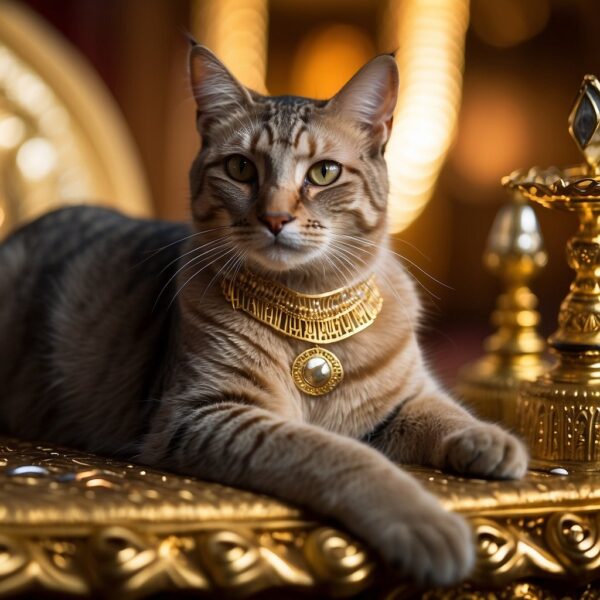
Worship and Religious Practices
The worship of Bastet, the feline goddess, was a complex element of ancient Egyptian religion, involving temples dedicated to her honor, specific rituals, and ceremonies, and grand festivals.
Temples and Sacred Spaces
Bubastis was the primary cult center for the worship of Bastet where a significant temple was dedicated to her. The city itself became a religious capital in the Nile Delta. Archaeological evidence indicates that the temple was home to numerous statues and sanctuaries, creating a space where worshippers could engage with the divine.
Rituals and Offerings
Worship rituals consisted of prayers and music, and it was common for devotees to bring offerings to Bastet’s temple. These offerings included small figurines of cats, crafted in bronze, which were offered to seek her favor or to give thanks. Additionally, mummified cats were presented as sacrifices, believed to act as an intermediary between supplicants and the deity.
Festivals and Celebrations
The most prominent annual festival in honor of Bastet was known as “The Feast of Bubastis,” which attracted devotees from across Egypt. The revelry included music, dancing, and river processions. Herodotus, an ancient historian, recorded that the celebration of this festival was among the most elaborate and heavily attended in Egypt.
Bastet and the Egyptian Pantheon
In ancient Egyptian religion, Bastet held a dynamic position within the pantheon, signifying both nurturing and protective aspects, and maintaining close ties with other deities through her multifaceted roles.
Relationship with Other Deities
Bastet was often associated with Sekhmet, another lioness goddess, emphasizing their shared protective and warlike aspects. In contrast to Sekhmet’s fierce nature, Bastet embodied a more gentle side, though she too could exhibit ferocity if required. With Hathor, deity of love and beauty, Bastet shared common traits and at times they were considered interconnected, with Hathor sometimes assumed to be Bastet’s mother.
The connection with Isis stems from Bastet’s role in the Osirian myths where she guarded Isis and her son Horus, providing them shelter and safety. Bastet was also linked with Mut, the mother goddess, reiterating her protective nature towards children and families.
- Relations with Other Deities:
- Protective role similar to Sekhmet
- Gentle counterpart to Sekhmet‘s ferocity
- Associated with Hathor‘s aspects of love and beauty
- Guardian in myths featuring Isis and Horus
Bastet and the Protection against Evil
Bastet was revered for her protective qualities, particularly as a defender against evil forces. She was believed to wield apotropaic magic, which ancient Egyptians held of high importance in warding off evil spirits and misfortune. Figures of Bastet were often used as amulets or placed in homes, indicating her role in everyday life as a safeguard.
The goddess was also involved in the practice of protective spells, which she would use to shield individuals, particularly children and mothers, from harm. This role highlighted her as a guardian deity within the pantheon, ascribing her as a crucial symbol of protection for ancient Egyptians.
- Bastet’s Protection Aspects:
- Apotropaic magic to repel evil
- Amulets for safeguarding homes
- Protective spells emphasizing her guardian role

Cultural and Artistic Influence
Bastet’s widespread veneration in ancient Egypt is well reflected in cultural and artistic realms. She becomes a conduit linking art, music, dance, and societal customs, influencing not only Egyptians but also neighboring civilizations.
Bastet in Egyptian Art
In Egyptian art, Bastet is often depicted as a lioness or a woman with the head of a lioness early in Egyptian history, symbolizing her protective and warlike aspects. Gradually, her image softened to a domestic cat, emphasizing her nurturing characteristics—a testament to her evolving role in Egyptian society. The depictions of Bastet were not merely ornamental but served as a spiritual homage, underscoring her prominence. Art during this period frequently showcased domestic cats as sacred beings, representing Bastet’s protective aura.
- Statues: Small figurines and grand statues of Bastet, found in homes and temples, exemplify her role as a protector.
- Reliefs: Wall reliefs in temples often capture Bastet in a stance of guardianship, signifying her as the defender of the pharaoh and Egypt.
Impact on Music and Dance
Bastet was not only a visual icon but also an inspiring figure for music and dance, contributing to the cultural tapestry of celebrations devoted to her honor. She was seen as the goddess of joy, perhaps leading to her association with music.
- Musical Instruments: Depictions of musical instruments in art dedicated to Bastet highlight the joyous celebrations in her name. Instruments such as sistrums—a rattle-like musical instrument associated with her cult—were played in ceremonies to evoke her presence.
- Dance: Dance performances at festivals and rituals often told stories of gods and goddesses, with Bastet being a favorite subject due to her spirited disposition.
The influence of Bastet extended beyond the borders of Egypt. The Greeks, for instance, integrated Bastet into their pantheon, equating her with the goddess Artemis. They adopted the feline deity’s attributes, further spreading her cultural and artistic impact across their society.
Modern-Day Legacy
Bastet, the ancient Egyptian goddess, continues to influence and fascinate people in the modern era. Her legacy is especially evident in popular culture and the perpetual enchantment her persona carries.
Influence on Popular Culture
Bastet has made numerous appearances in contemporary media, reflecting her status as an iconic figure of ancient mythology. For instance:
- In Literature: She features in Neil Gaiman’s fantasy novel “American Gods,” where she is depicted as one of the old gods trying to navigate a landscape dominated by new deities and ideals.
- In Comics and Graphic Novels: Bastet often appears as a character drawing on her attributes of protection and feline grace.
The Enduring Allure of Bastet
The qualities of protection and nurturing ascribed to Bastet in ancient times have facilitated her enduring allure. Attributes such as her role as a protector, often symbolized by her depiction as a fierce lioness or a domesticated cat, resonate with modern audiences who look towards historical figures for inspiration. Moreover, the Egyptian goddess continues to be venerated by some pagan and neopagan practitioners, who perceive her as a powerful symbol of feminine energy and guardianship.
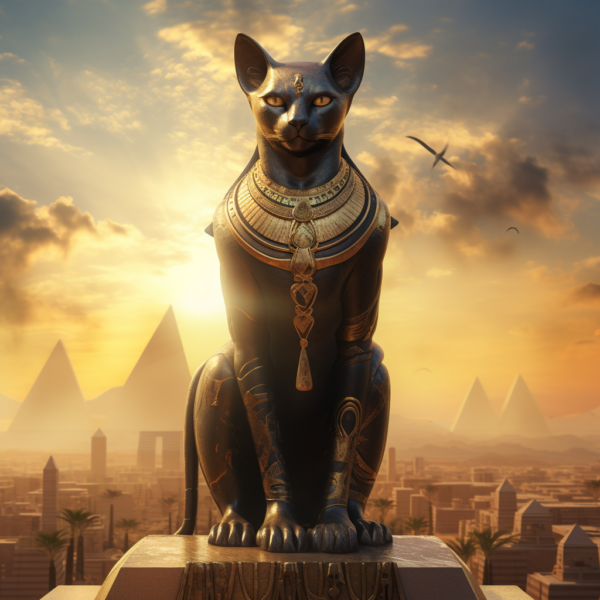
Archaeological and Historical Insights
The archaeological findings related to Bastet reveal significant practices like feline mummification and the production of artefacts which reflect her influence on the Egyptian society.
Feline Mummification and Burials
Archaeological Evidence: Excavations have unearthed numerous mummified cats and kittens that were offered to Bastet as votive objects.
- Sites: Key sites include Bubastis, the main cult center of Bastet, and Saqqara, where early evidences have been found.
- Practices: These mummified cats, often entombed with care, suggest the depth of adoration and reverence for Bastet which extended to the domestic cat.
Artefacts and the Legacy of Bastet
Iconography and Symbolism: Artefacts bearing the likeness of Bastet often depict her as part lioness and part domestic cat, symbolizing her dual nature of nurturing and protecting.
- Amulets: These were commonly worn for personal protection and to invoke Bastet’s favor.
- Egyptian Art: She often appears in paintings, sculptures, and as statuettes demonstrating her significant role in the royal and domestic spheres.
- Tomb Artifacts: In tombs, items associated with Bastet were included to safeguard the deceased in the afterlife.
Materials: The artefacts range from bronze to gold, emphasizing her standing among deities. The inclusion of amulets and statuettes in tombs alongside mummies underscores the Egyptians’ hopes for divine protection.
Bastet’s Broader Influence
Bastet, the enigmatic Egyptian cat goddess, transcended regional worship within Lower Egypt to leave her mark on various cultures and religions. Her veneration as a deity of home, fertility, and protection illustrates her role’s significance in the ancient world.
Bastet’s Role Beyond Egypt
The cult of Bastet was not restricted to the geographic boundaries of early civilizations in Lower Egypt. Herodotus, the ancient historian, documented the widespread reverence for Bastet outside of Egypt. Contemporaries beyond its borders were known to acknowledge and sometimes integrate Bastet into their own religious practices. The spread of her worship can be seen as a testament to the exchange of cultural and religious ideas along trade routes and through interactions between diverse civilizations.
Connections with Other Cultures and Religions
- Integration with Greek Deities: Bastet’s characteristics were sometimes likened to those of Greek deities such as Artemis, blending religious beliefs and contributing to her worship among Greek populations.
- Influence on Later Cults: Elements of the worship of Bastet found their way into various subsequent cults, evidencing a lingering spiritual legacy.
- Presence in Eastern Traditions: Vestiges of Bastet’s influence have been identified in certain Eastern traditions, underscoring her impact on a broader religious landscape.
Bastet’s cultural permeation across different societies underscores her wider ecclesiastical significance, extending her influence from Lower Egypt to far-reaching corners of the ancient world.
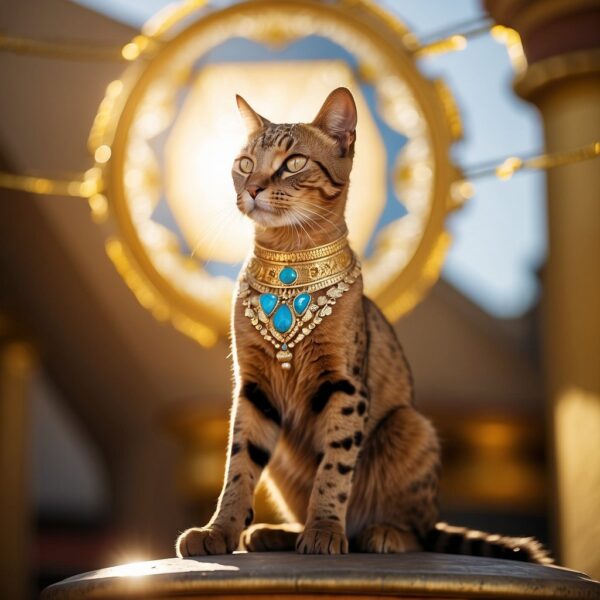
Frequently Asked Questions
In this section, readers can find quick and concise answers about Bastet, the celebrated Egyptian Cat Goddess, addressing her attributes, mythology, cultural significance, facts, and her relationships with other deities.
What are the attributes and symbols associated with Bastet?
Bastet is typically represented with a lioness or domestic cat head, signifying her as a goddess of home, fertility, and childbirth. Symbols associated with Bastet include the sistrum, a musical instrument, and the lioness, reflecting her initial fierce aspect.
Could you share the mythology surrounding Bastet?
In myth, Bastet started as a lioness goddess named Sekhmet, a fierce protector and warrior. Later, her image softened to that of a domestic cat, embodying protection, music, dance, and family. Bastet also played a role in the afterlife, defending against evil spirits.
What cultural significance does Bastet hold in ancient Egyptian beliefs?
Bastet was central in ancient Egyptian culture, representing the protective and nurturing aspects of feline companionship. She was venerated in the city of Bubastis, with grand festivals held in her honor. Ancient Egyptians also believed Bastet would grant good fortune to those who cared for cats.
What are some fascinating facts about the deity Bastet?
It was considered highly auspicious and a blessing to be favored by cats, which were linked to Bastet. Additionally, the ancient Egyptians placed great importance on the protection of cats and harshly punished any harm brought to them, due to their association with Bastet.
How did Bastet’s portrayal evolve over time in ancient Egypt?
Bastet’s portrayal evolved from the fierce lioness warrior, known as Sekhmet, to a gentler domestic cat goddess. This change reflected the domestication of cats around 1500 BCE and society’s evolving view of the protective and maternal traits of women.
What is the relationship between Bastet and other Egyptian deities like Anubis?
Bastet was considered the daughter of the sun god Ra and is often linked to deities such as Anubis, the god of mummification and the afterlife. While Anubis presided over mummification, Bastet offered protection; together they played complementary roles in Egyptian religious beliefs.